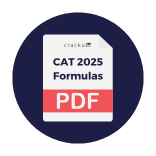Edit MetaData
Educational materials for IPMAT and IIMB UG preparation
Welcome to Adda
9 years, 7 months ago
What is the best way to solve question related to Cube via analysing question (which is time taking) or it has some tricks ??
- Copy Link
9 years, 7 months ago
Hi Shubham,
The following points have to be kept in mind:
The unit cubes which have no face painted are the cubes which cannot be seen from outside. In this case the number of such cubes is 27.
The unit cubes which have exactly 3 faces painted are the ones at the corners of the big cube. Irrespective of the dimensions of the bigger cube, this number is always 8.
The unit cubes which have exactly one face covered by paint are the ones which reside in the interior region on the faces (cubes not touching the boundary). There are 6 faces in each cube. In this case, the number of cubes with 1 face painted is 3*3*6 = 54.
The unit cubes which have exactly 2 faces covered by paint reside on the edges of the cube (cubes which are at the corners do not belong to this category ). In this case, it is 3*12 = 36.
In general, for an n X n X n cube,
The total number of unit cubes is $$n^3$$.
The number of unit cubes which cannot be seen = number of unit cubes which have 0 faces painted = $$(n-2)^3$$.
The number of unit cubes which have exactly 3 faces covered by paint = 8.
The number of unit cubes which have exactly 2 faces covered by paint = 12*(n-2).
The number of unit cubes which have exactly one face covered by paint = 6*$$(n-2)^2$$.
In general, for a cuboid of dimensions p X q X r,
The total number of unit cubes = p*q*r.
The number of unit cubes which cannot be seen = number of unit cubes which have 0 faces painted = (p-2)*(q-2)*(r-2).
The number of unit cubes which have exactly 3 faces covered by paint = 8.
The number of unit cubes which have exactly 2 faces covered by paint = 4*(p-2) + 4*(q-2) + 4*(r-2).
The number of unit cubes which have exactly one face covered by paint = 2*(p- 2)*(q-2) + 2*(q-2)*(r-2) + 2*(r-2)*(p-2).



